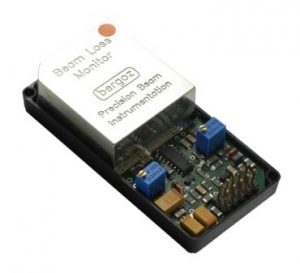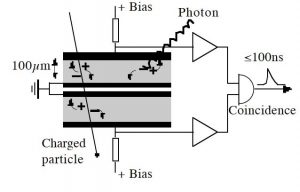Principle
The charged particle crosses both PIN diodes, causing a coincidence.
Synchrotron radiation photons, if stopped by either PIN-diode, do not cause a coincidence.
K. Wittenburg was awarded the Faraday Cup in 2000 for the design of the PIN photodiode Beam Loss Monitor and its implementation at HERA.
Bergoz Instrumentation was granted a license by DESY to use Wittenburg's original development.
Main features
- Single particle detection efficiency > 30 %
- Spurious count rate < 0.1 Hz
- Maximum count rate > 10 MHz
Downloads
Datasheets
User's manual
Papers
- BLM-Anka
- BLM-Dafne
- BLM-Hera-Proton ring
- BLM-HLS
- BLM-SRRC
- BLM-Tevatron
- Electron-BLM-Hera
- Experience-BLM
- SL-note-96-26
Current price list
Features
- Very small size and low unit cost make it possible to monitor all locations where beam loss is predicted.
- Vacuum quality around the storage ring can be measured based on BLM count rate.
- Two PIN-photodiodes mounted face-to-face detect charges particles. Coincidence counting makes it insensitive to synchrotron radiation photons.
- Spurious count very low: < 1 count in 10 seconds. • Up to 10MHz counting: dynamic range >10E8
- Recovers 100ns after a hit
- Choice of detector solid angle: Large PIN-diodes can be user installed
- Output is a TTL compatible pulse: easy counting
- Tested up to 108 Rads for hardness


